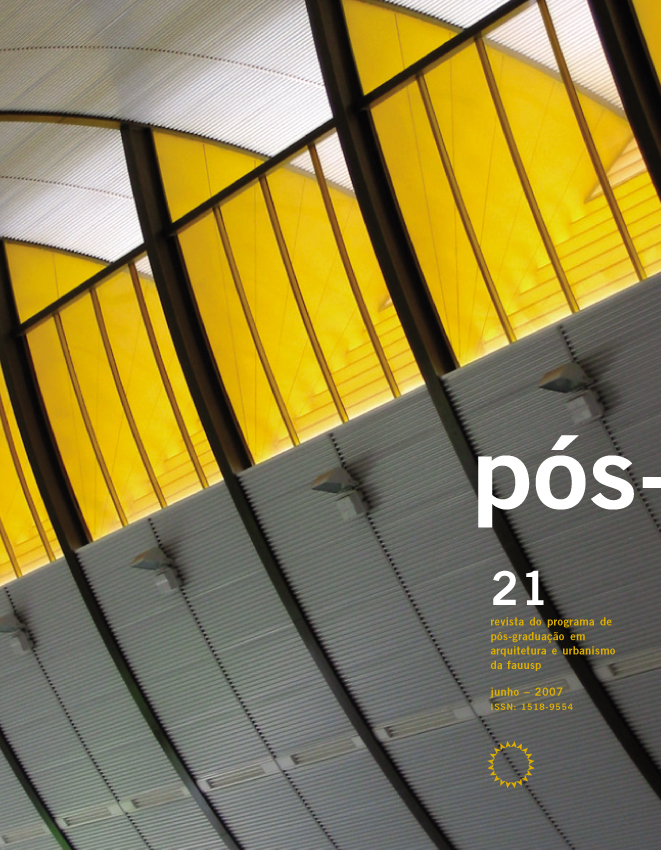Monumentality vs. everyday life: architecture's public role
DOI:
https://doi.org/10.11606/issn.2317-2762.v0i21p26-49Keywords:
Monumentality, everyday life, nationAbstract
Conference held in Belo Horizonte, Minas Gerais, on March 18, 2006. Thoughts about architecture and the nation." Architecture is everything dealing with construction." (ARGAN, c. 1992). An object's cultural and ethical value is measured by how well it addresses demand, which in turn is related to the planet Earth, to scarce resources, and to people's survival. Architecture, its craft, and its teaching are studied from the perspective of the act, which is the art of building, to meet social, public and private demands through historical processes of power games, at a given place and time. Architecture is reduced to its essence to unveil the roots of its emergence and understand the architect's responsibilities in the new mass society, when we enter this" new popular period in history" (SANTOS; SOUZA, c1998). We suggest the following sequence of procedures as a path of knowledge and to support the free development of invention: 1) Initially assess the prospective problem to choose and study the location and the tasks of the architect, the client, society, and government; 2) identify and understand building plans for that location; 3) study the activities, flows, quantity, quality and combination of spaces resulting from the conflicting yearnings of people, in line with social needs and translated into private and public building plans; 4) graphically analyze the sectorial subsystems of areas associated according to affinities, considering their arrangement and organization in the site; 5) work on the rigorous construction of architecture, which in final analysis is matter and form; It should be pointed out that it is necessary to: 6) expand the supply of information on specific architectural problems to be addressed, and to organize the actual and effective involvement of people in the discussion of projects and works of their interest, unlike assembly and participative meetings; 7) expand opportunities to allow a greater number of architects to take part in building the nation, which implies the government implementing new recruitment policies. Three projects are presented to illustrate the involvement of architects in the architectural craft in Brazil: 1) Brasília's Pilot Plan, 1957; 2) the city of Caraíba, (Pillar), Jaguarari, Bahia, 1978; and 3) Bicocca project, in Milan, Italy, 1987.Downloads
References
ARGAN, Giulio Carlo. A história da arte como história da cidade. São Paulo: Martins Fontes, 1998.
BRANDÃO, Carlos Antônio Leite. A formação do homem moderno vista através da arquitetura. Belo Horizonte: UFMG, 1999.
CHARDIN, Pierre Teilhard de. Le phénomène humain. Paris: Editions du Seuil, 1955.
EISEMAN, Peter. Diagram diaries. Nova York: Universe Publishing, 1999.
GUEDES, Joaquim. Considerações sobre planejamento urbano, a propósito do Plano de Ação Imediata de Porto Velho. 1972. Tese (Doutorado) – Faculdade de Arquitetura e Urbanismo, Universidade de São Paulo, São Paulo, 1972.
GUEDES, Joaquim. Um projeto e seus caminhos. 1981. 293f. Tese (Livre-Docência) – Faculdade de Arquitetura e Urbanismo, Universidade de São Paulo, São Paulo, 1981.
HERZOG, Thomas. Bausysteme von construction systems by sistemi costruttivi di Angelo Mangiarotti. Darmstadt: Verlag Das Beispiel, 1998.
HOLANDA, Frederico de. Arquitetura & urbanidade. São Paulo: ProEditores, 2003.
MALDONADO, Tomás. Ambiente humano e ideologia. Buenos Aires: Ediciones Nueva Visión, 1972.
MANGIAROTTI, Angelo et al. In nome dell’architettura. Milão: Jaca Book, 1987.
NARDI, Giulio. Angelo Mangiarotti: Studio di una struttura. Dogana: Maggioli Editore, 1997.
REALE, Miguel. A ecologia e seus riscos. O Estado de São Paulo, São Paulo, 23 jun. 2001. Espaço Aberto, p. 2.
REED, Peter. Alvar Aalto: Between humanism and materialism. Nova York: The Museum of Modern Art, 1998.
SANTOS, Milton. Metrópole corporativa fragmentada: O caso de São Paulo. São Paulo: Nobel/Secretaria do Estado da Cultura, 1990.
VALÉRY, Paul. Eupalinos e o arquiteto. São Paulo: Editora 34, 1999.
Downloads
Published
Issue
Section
License

This work is licensed under a Creative Commons Attribution 4.0 International License.
DIADORIM - Diretório de Políticas Editoriais












